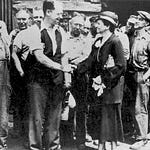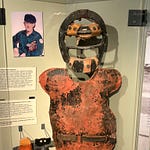Between 1915 and 1970, the Ohio River was more than a border between North and South—it was a corridor of change. As millions of African Americans left the rural South in what came to be called the Great Migration, cities like Pittsburgh, Cincinnati, Louisville, and Cairo became places of arrival where new communities took root.
Why did so many leave? Some were pulled northward by wartime jobs that could no longer be filled by low-wage immigrant workers. Others were pushed by violence, poverty, and political exclusion in the South. Trains heading to Pittsburgh or Chicago were often full of passengers carrying not much more than a suitcase and a lead from a cousin or neighbor who had gone before.
Isabel Wilkerson documents this on a national scale in The Warmth of Other Suns (2010), a deeply researched narrative history of the Great Migration that uses personal stories to illuminate what moved people, where they went, and what they left behind. The book won major awards, including the National Book Critics Circle Award for Nonfiction and the Anisfield-Wolf Award. She also shared these insights in a widely viewed TED talk.
The reception in the Ohio Valley was complicated. Industries needed hands, but employers often confined newcomers to the dirtiest and most dangerous jobs. Middlemen cropped up, sometimes helping, sometimes exploiting. Housing was another battle: in Cincinnati, the West End became a crowded hub later targeted for “urban renewal”; in Pittsburgh, the Hill District thrived culturally even as city planners bulldozed blocks for highways and stadiums; in Louisville, Black families were steered into neighborhoods like Smoketown and the West End.
Migration also shifted the balance of political power. Where voting rights were less restricted, Black communities could organize, cast ballots, and even tip elections. That influence sparked new opportunities as well as new forms of resistance. We still see echoes of this today in debates over redistricting, representation, and voting rights — reminders that the Great Migration continues to shape American life.
From steel towns to stockyards, from church basements to union halls, the Great Migration reshaped the Ohio River valley in ways still visible today. The questions that follow will help you trace how work, politics, housing, and community life along the river were transformed by this movement of people.
Note to my fantastic new subscribers:
Monthly trivia is for sport. It’s not a test of intelligence or character. Do your best and enjoy learning something new. Oh, and if you do, would you share the quiz with someone else?
QUESTIONS
Answers in the footnotes.
1. Why did the Great Migration accelerate in states like Pennsylvania, Ohio, Indiana, and Illinois during WWI?1
A. Northern industries recruited Black workers to replace European immigrants whose migration slowed
B. Southern states began subsidizing train fare north
C. Black newspapers advertised opportunities in Northern cities
D. Federal New Deal programs required quotas of Black workers
2. Who were “labor brokers” (also called “labor agents”) during the Great Migration, and why were they controversial?2
A. Recruiters hired by Northern industries to bring Southern Black workers north
B. Middlemen who sometimes exploited migrants by taking a cut of their wages or charging fees
C. Community leaders who voluntarily helped migrants find housing and jobs without pay
D. Organizers who tried to unionize Black workers as soon as they arrived
3. When Black Southerners arrived in Northern states, many employers assumed they would be best suited for which kinds of jobs?3
A. Domestic service and janitorial work
B. Stockyards and meatpacking plants
C. Foundries and steel mills
D. Agricultural and food-processing labor (e.g., canneries, sugar beet fields)
4.How did Black migration reshape politics in Ohio River states (PA, WV, KY, OH, IN, IL)?4
A. African Americans gained the right to vote without poll taxes and literacy tests
B. The Black vote began to swing elections in cities like Chicago and Cleveland
C. Both major political parties ignored Black voters until after WWII
D. Migration triggered white backlash and restrictive housing covenants
5.What role did the Pennsylvania Railroad (PRR) play in the Great Migration?5
A. It provided free rides north for Southern migrants
B. It hired thousands of Black workers as porters, track laborers, and dining car staff
C. It ran ads in Black newspapers promoting Pittsburgh and Philadelphia jobs
D. It lobbied Congress to restrict Black migration to control wages
6.By 1970, how had the Great Migration reshaped cities along the Ohio River?6
A. Louisville’s Black population grew as rural Kentuckians moved into the city for industrial and wartime jobs
B. Cincinnati’s West End became a major Black community before being decimated by urban renewal
C. Pittsburgh’s Hill District flourished culturally but faced job losses as steel began to decline
D. Cairo, Illinois, became a safe haven for Black migrants
7.How did U.S. Steel shape the Great Migration in Pittsburgh and other Ohio River steel towns?7
A. It recruited Black workers to fill labor shortages, especially during WWI and WWII
B. It smoothed the transition by giving Black workers a month of free housing in mill towns
C. It sometimes used Black workers as strikebreakers, straining relations with white immigrant labor
D. It helped fund Black newspapers to support migrant communities
8.What role did the meatpacking and stockyards of Louisville and Cincinnati play in the Great Migration?8
A. They hired Southern Black migrants into grueling, low-wage slaughterhouse and processing jobs
B. They provided pathways into stable union jobs from the very beginning
C. They became organizing grounds where Black workers later joined interracial CIO unions in the 1930s
D. They were entirely closed to Black labor until after WWII
9.How did Pullman porters influence Black migration and community life in Ohio River cities like Cincinnati and Louisville?9
A. They provided steady, respected work for Black men, though under harsh conditions and low pay
B. They carried The Chicago Defender and other Black newspapers south, spreading word about Northern opportunities
C. They organized one of the first national Black labor unions, the Brotherhood of Sleeping Car Porters
D. They ensured that Black families in river cities were exempt from housing segregation
10.How did housing policies and practices affect Black migrants in Ohio River cities?10
A. Restrictive covenants and redlining confined Black families to segregated neighborhoods
B. Urban renewal projects displaced Black communities, often in the name of “slum clearance”
C. Federal housing programs after WWII encouraged integrated, mixed-race suburbs
D. Despite barriers, Black neighborhoods like Pittsburgh’s Hill District and Cincinnati’s West End fostered strong cultural and political life
If you’ve lived in or near these places — the Hill District in Pittsburgh, Cincinnati’s West End, Smoketown in Louisville — what stories have come down in your family?
Intermission
I was recently in Cincinnati, getting to know more about Black History and the West End. This video includes much of what I discovered there:
ANSWERS
Answers: A, C. The First World War disrupted immigration from Europe, cutting off a major supply of industrial labor. Northern factories and railroads turned to Black workers, recruiting them through ads in newspapers like The Chicago Defender. These papers circulated deep into the South—sometimes hand-carried by Pullman porters—spreading the word about jobs in Pittsburgh’s steel mills, Cleveland’s factories, and Chicago’s stockyards. Southern states, far from subsidizing the movement, often tried to stop it because they feared losing their workforce.
Answers: A, B. Labor brokers traveled South to recruit Black workers for jobs in Northern steel mills, railroads, stockyards, and farms. They promised steady wages and covered train fare, but they often profited unfairly by deducting fees or controlling workers’ paychecks. Some Southern politicians tried to outlaw labor agents, fearing the exodus. While controversial, they were a critical link between rural towns in Kentucky or Mississippi and industrial jobs in Pittsburgh, Cincinnati, or Chicago.
Answers: A, B, D. Employers often typecast Black workers into “servant” or “stoop labor” roles, including agricultural processing, canning, and sugar beet work in places like Ohio and Indiana. Stockyards and meatpacking in Chicago and Cleveland also drew many migrants. While some Black workers broke into heavy industry, they were often excluded from the best-paid steel mill and foundry jobs, which went first to white and immigrant workers.
Answers: A, B, D. In the Ohio River states, migration reshaped politics by bringing new voters into urban centers. Even in West Virginia, Black coal miners participated in union politics and tipped the balance in close elections. But this power also provoked restrictive housing practices and segregationist backlash. As for Answer C: both parties actively courted Black voters in the 1920s and 1930s, though often in transactional or limited ways. What is correct about Answer C is that Black voting blocs were influential well before WWII, and their growing power also provoked white backlash (housing restrictions, redlining, etc.).
Answers: B, C. The PRR actively recruited Black workers, advertising in the South and hiring thousands into service and track jobs. Free rides and congressional lobbying weren’t part of the story. While other railroads also hired Black labor, the PRR’s size and reach made it especially influential: it was the largest railroad in the world, with lines converging on Pittsburgh and Philadelphia. Its recruiting efforts fed directly into the growth of Pittsburgh’s Hill District and other Ohio Valley Black neighborhoods, giving it a demographic impact that smaller competitors like the B&O or L&N never matched.
Answers: A, B, C. Although Kentucky as a whole sent more people out than it retained, Louisville grew as a migration hub. Its industries, railroads, and wartime factories attracted rural Black Kentuckians seeking opportunity, even as housing segregation confined them to places like the West End and Smoketown. Cincinnati and Pittsburgh also became centers of Black life, though both faced economic restructuring and displacement. Cairo, meanwhile, was wracked by violent racial conflict and never a safe haven.
Answers: A, C. U.S. Steel actively recruited Black workers from the South during labor shortages, particularly in wartime, and sometimes used them as strikebreakers—especially in 1919—undermining solidarity with immigrant laborers. But it did not provide free housing or fund Black newspapers; in fact, many migrants faced overcrowded, exploitative housing and relied on their own institutions and press for community support. In Pittsburgh, this pattern was visible at the Homestead Works and other mill towns, where Black migrants lived in the Hill District and nearby neighborhoods while working some of the hardest and lowest-paid jobs in the mills.
Answers: A, C. Stockyards in both cities hired Southern migrants into grueling, low-wage jobs handling and processing animals. Conditions were bloody, exhausting, and segregated, but the steady pay was still better than sharecropping. By the 1930s–40s, Black workers helped reshape unions like the United Packinghouse Workers of America, which became among the most racially progressive in the labor movement. The stockyards thus became both sites of exploitation and crucibles of interracial organizing.
Answers: A, B, C. The rail lines converging on cities like Cincinnati and Louisville made them hubs for Pullman porters. These jobs provided steady, if exhausting, work and carried prestige within Black communities, even though pay and conditions were harsh. Porters distributed Black newspapers such as The Chicago Defender across the South, spreading word about opportunities in Northern cities. In 1925, A. Philip Randolph organized the Brotherhood of Sleeping Car Porters—the first successful Black-led national union. Unlike jobs tied to one railroad, porters worked across multiple lines nationwide, which gave them unusual reach and influence. Their routes connected the Ohio Valley directly to both Southern recruiting grounds and Northern destinations, making them vital carriers of information and community ties.
Answers: A, B, D. Housing was one of the greatest challenges for Black migrants. Real estate covenants, lending discrimination, and outright violence confined families to certain areas, while federal programs like the GI Bill deepened segregation by underwriting white suburbs. Urban renewal bulldozed thriving Black neighborhoods, especially along the Ohio River (Cincinnati’s West End, Louisville’s Walnut Street, Pittsburgh’s Hill District). Yet within these constraints, Black communities created vibrant cultural and political institutions. I wrote about this in Evansville last year.










